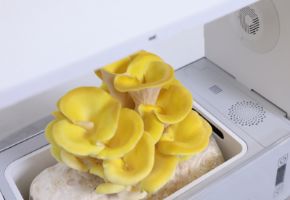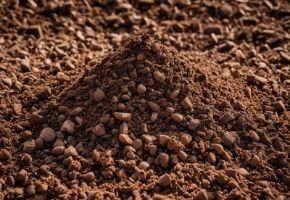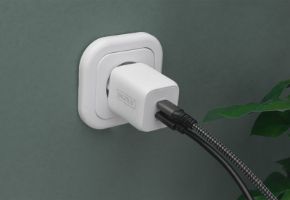Ganoderma Lucidum - Reishi Substrate
The Ganoderma Lucidum - Reishi substrate allows you to easily grow mushrooms inside the Grow Box. Simply insert the block into the machine after making some cuts on the packaging. A product increasingly recognized for its great beneficial properties can now be grown at home without complex sterilization operations or mixing of mycelium and culture medium. But let's discover its characteristics together!
Basic information
Class: Basidiomycetes
Scientific Name: Ganoderma Lucidum
Common Names: Reishi – Varnished Conk – Ling Chih - Ling zhi
Characteristics
Cap: up to 15 cm in diameter, circular, kidney-shaped or fan-shaped, with a vertical or oblique stem, glossy-lacquered or matte surface in very old age, reddish-brown color, with a yellowish cap edge, often with concentric stripes giving it a zoned appearance.
Gills: not present, replaced by a network of short tubes, 10-20 mm high, white and then yellowish.
Stem: eccentric, same color as the cap or darker, variable size 15-30 cm, nodular, glossy, rarely absent.
Flesh: elastic, then leathery, woody but not too much, almost rusty.
Spore: brown in mass, ovoid, with a truncated apex, warty, 9-11.5 x 6-9 µm.
Natural Habitat
Ganoderma Lucidum has a limited distribution in Europe and some parts of China, where it grows on decaying hardwood trees. Wild populations have been found in the United States in California and Utah, but they were likely introduced anthropogenically and naturalized. It is a parasitic or saprophytic fungus that prefers oak or chestnut wood; it is known in China for its medicinal properties but now with the grow-box, you can grow it fresh directly at home!
Cultivation Requirements
Temperature: 25-30°C for mycelium growth, 20-25°C for fruiting
Humidity: 60-70% during colonization, 85-90% during fruiting
Tips
- Growth stages: most mushrooms have two main growth stages: substrate colonization by the mycelium and fruiting (production of fruiting bodies). These stages often require slightly different conditions.
- Ventilation: in addition to temperature and humidity, proper ventilation is crucial, especially during the fruiting stage. It helps prevent the formation of unwanted molds and bacteria and stimulates the formation of fruiting bodies.
- Substrate: the type and quality of the substrate significantly influence growth. Each species has specific substrate preferences.
- Light: although mushrooms do not photosynthesize, many species require a certain amount of light to stimulate fruiting and determine growth direction, which is where the Grow Box with its lighting bodies becomes useful for cultivation!
- pH: the pH of the substrate is another important factor. Most mushrooms prefer a slightly acidic environment, with a pH between 5.5 and 6.5. In the case of a ready-to-use substrate like this, it is not an element you need to worry about as the product is already mixed and inoculated!
- Thermal shock: thermal shock can create problems in mycelium propagation or fruiting, generating molds and contaminants in the substrate, on primordia, or on the mushrooms themselves. Only some species, like Shiitake, benefit from a thermal shock (temporary exposure to lower temperatures) to stimulate fruiting.
- Humidity cycles: some growers practice humidity cycles, alternating periods of high humidity with periods of slight drying, to stimulate the production of fruiting bodies. In this case, it will be sufficient to keep the tray and display monitored. If the temperature rises excessively and humidity drops below a certain threshold, it is recommended to temporarily turn off the lights.
- Contaminations: controlling temperature and humidity is also crucial to prevent the growth of contaminating organisms such as molds and bacteria. If yellow spots or yellow liquid appear on the substrate, it means the fungus has come into contact with a contaminant and is reacting by producing an antibiotic substance (the liquid).
- Adaptation: fungal species can slightly adapt to conditions different from optimal ones, but this can affect yield and quality of fruiting bodies.
- Constant monitoring: given the sensitivity of mushrooms to environmental conditions, constant and precise monitoring of temperature and humidity throughout the growth cycle is essential. Since the grow box is not only a cultivation tool but also a piece of furniture, you can always keep your mushrooms under surveillance comfortably in your living room!
Organoleptic properties
This edible mushroom is suitable not only for medicinal and therapeutic use but also for culinary use once dried (especially in soups or dried and powdered as coffee). The smell is light, pleasant, tannin-like, and the taste is woody and tannic.
Nutritional Properties
From a nutritional point of view, the Reishi mushroom has reported a composition of 11.1% glucose, 10.2% minerals (including potassium, magnesium, and calcium), and 7.3% proteins. In addition to these components, Ganoderma also contains a variety of biologically active molecules, including polysaccharides, triterpenes, flavonoids, alkaloids, steroids, unsaturated fatty acids, or enzymes.
The main responsible for the therapeutic properties of Ganoderma are polysaccharides and triterpenoids, which have been the focus of many scientific studies. Ganoderma has excellent antioxidant properties and helps counteract excess free radicals and the resulting oxidative stress, with positive implications for overall health. Polysaccharides, in fact, reduce lipid peroxidation and have a positive impact on glutathione activity with enormous benefits for the immune system.









